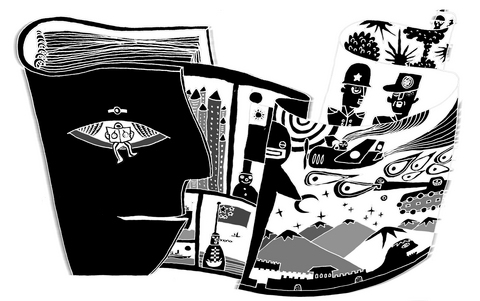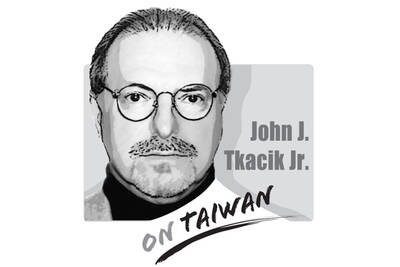Every nation has its founding myth. For the People's Republic of China, it is the Long March -- a story on a par with Moses leading the Israelites' exodus out of Egypt. I was raised on it.
The myth can be stated succinctly. The fledgling Chinese Communist Party and its three Red Armies were driven out of their bases in the South in the early 1930s by Chiang Kai-shek's (
After two years and 16,000km of endurance, courage, and hope against impossible odds, the Red Armies reached northwest China. Only a fifth of the 200,000 soldiers remained, worn out, battered, but defiant. A decade later, they fought back, defeated Chiang, and launched Mao's New China.

How does China's founding myth stand up to reality?
In 2004, 70 years after it began, I set out to retrace the Long March. It remains a daunting journey, through areas little changed to this day, inaccessible and desperately poor. Of the 40,000 survivors, perhaps 500 are still alive; I tracked down and interviewed 40 of them -- ordinary people who were left behind or managed to reach the end, but with stories that are highly instructive.
Huang Zhiji was a boy, little taller than his rifle, when he joined the Red Army. He had no choice: they had arrested his father and would not release him until Huang agreed. He thought of deserting, but stayed for fear of being caught and shot. Many did run away. Six weeks into the march, Mao's First Army was reduced from 86,000 troops to 30,000. The loss is still blamed on the Xiang River Battle, the army's first big engagement of the march. But at most 15,000 died in battle; the rest vanished.
Another battle, over the Dadu River, is the core of the Long March legend. Twenty-two brave men supposedly overpowered a regiment of Nationalist troops guarding the chains of the Luding Bridge with machine guns and opened the way for the marchers. Mao told Edgar Snow, author of Red Star Over China, that crossing the Dadu River was the single most important incident during the Long March, and today it is eulogized as such.
But documents I have seen indicate that the general who commanded the division that crossed the Dadu River first told party historians a very different story.
"This affair was not as complicated as people made it out to be later," he said. "When you investigate historical facts, you should respect the truth. How you present it is a different matter."
So the legend lives on. There was only a skirmish over the Dadu River. The local warlord, who hated Chiang Kai-shek, let Mao pass. As a reward, he was later made a minister in the communist government.
The marchers did not know where they would end up. There were constant debates about the final destination. When they converged in northern China in October 1936, it was hailed as the end of the march. But the "promised land" was not as promised. It could barely support its own population, let alone the Red Armies.
Soldiers had no clothes to protect them from freezing cold. Women were ordered to turn back and go home because there was not enough food. Barely a month after the union of the three Red Armies, the party decided that the Long March was to continue. But the kidnapping of Chiang by the general he had appointed to wipe out the communists saved them. As part of the price for his release, Chiang recognized the communists as legitimate. The Long March was over.
Not, however, for the 21,000 men and women of the Western Legion. They belonged to the Fourth Army, headed by Zhang Guotao (
Trapped in barren land where survival was difficult, the overwhelming forces of Muslim warlords wiped them out. Only 400 reached the border; the rest were killed or captured.
It was the Red Army's biggest defeat. Yet it is missing from official history. Wang Quanyan (王泉媛), a senior officer, was taken by a Muslim commander as a concubine. That was enough to make her a traitor in the eyes of the party, negating all her years of dedication. She and the rest of the Fourth Army survivors had to fight for half a century to be recognized as marchers.
The Long Marchers persevered, fought, starved, despaired and endured. Hunger drove the armies to take hostages for ransom. Purges continued until practically no officers were left to command battles. If the marchers had doubts, they conquered them with the help of communist propaganda. They rose to their ordeal with a bravery and self-sacrifice unsurpassed in China's or anyone's history.
What motivated them?
I asked a top general what he knew of communism at the time.
"I had no idea then and now," he replied. "I doubt that even Mao knew what it was."
For him, a survivor of extreme poverty and oppression, communism was a beautiful, sustaining dream, the hope of a just and advanced society.
Perhaps no one knew or could know how much suffering would lie ahead, how vast the sacrifice would be, and how great the difference would be between the dream and the reality.
Sun Shuyun (孫書雲) is author of The Long March, to be published this month. Copyright: Project Syndicate
A 50-year-old on Wednesday last week died while under anesthesia at a Taipei cosmetic clinic shortly after undergoing a penis enlargement procedure. The surgeon was arrested for suspected medical malpractice, again bringing to the surface shortcomings in the regulation of cosmetic medicine. Media reports said the clinic owner and surgeon, surnamed Ting (丁), was previously convicted of negligent homicide for a postsurgical death and had been charged with coercion and aggravated assault after allegedly stopping a patient from calling for an ambulance. He had also been fined for failing inspections and had allegedly permitted people without medical licenses to assist

It was most annoying last week to read Chairman Xi Jinping’s (習近平) fulsome encomium to the People’s Liberation Army during the Eightieth Anniversary celebrations of victory over Japan in World War II. Comrade Xi’s soaring rhetoric was stuffed with “martyrs, sacrifice, solemnity and unwavering resolve” in praise of the “Chinese People’s War of Resistance Against Japanese Aggression and the World Anti-Fascist War.” His aspirations overflowed with “world peace” and love of the United Nations, of which China is a founding member. The Liberation Army Daily said that every word from General Secretary Xi Jinping “resounded in his powerful voice, illuminating the
An American Institute in Taiwan (AIT) spokesperson on Saturday rebuked a Chinese official for mischaracterizing World War II-era agreements as proving that Taiwan was ceded to China. The US Department of State later affirmed that the AIT remarks reflect Washington’s long-standing position: Taiwan’s political status remains undetermined and should only be resolved peacefully. The US would continue supporting Taiwan against military, economic, legal and diplomatic pressure from China, and opposes any unilateral attempt to alter the “status quo,” particularly through coercion or force, the United Daily News cited the department as saying. The remarks followed Chinese Minister of Foreign Affairs
OpenAI CEO Sam Altman recently sat down for an interview with former Fox News host Tucker Carlson in which he openly acknowledged that ChatGPT’s model behavior is indeed influencing the entire world, and that he himself is responsible for the decisions related to the bot’s moral framework. He said that he has not had a good night of sleep since its launch, as the technology could bring about unpredictable consequences. Although the discussion took place in the US, it is closely related to Taiwan. While Altman worries about the concentration of power, the Chinese Communist Party (CCP) has already weaponized artificial